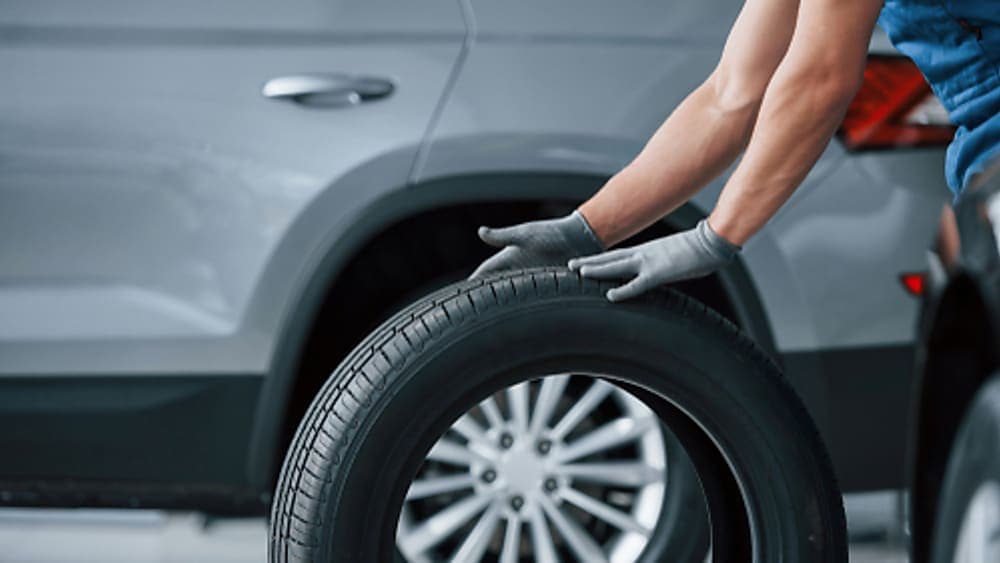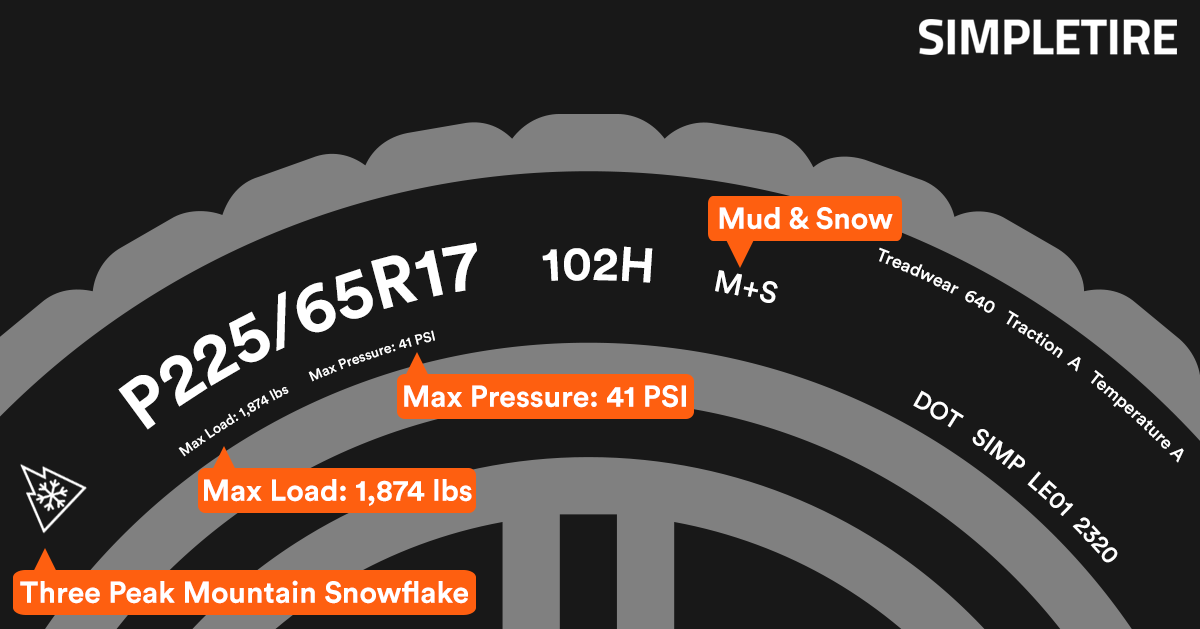Tire maintenance & safety
Free shipping
Best price guarantee
Special pricing
Financing with Resolve
Easy returns

The tire sidewall is a crucial component of every tire, yet it often goes unnoticed by vehicle owners. This part of the tire contains vital information that can help you make informed decisions about tire maintenance, safety, and performance.
Tire sidewalls are designed to withstand significant stress and pressure while providing a smooth and comfortable ride. However, they are also susceptible to damage from road hazards, improper inflation, and general wear and tear.
Understanding the importance of tire sidewalls and how to properly maintain them can help extend the life of your tires and ensure your vehicle's safety on the road. In this article, we'll explore the key aspects of tire sidewalls and provide tips on how to keep them in top condition.
What is a Tire Sidewall?
The tire sidewall is the area of a tire between the tread and the bead. It is a critical component of the tire's structure, providing lateral stability and protecting the inner layers from damage. The sidewall is made up of multiple layers of rubber compounds, reinforced with fabric or steel cords, depending on the tire's design and intended use.
One of the most important functions of the tire sidewall is to display essential information about the tire's specifications. This information is molded into the sidewall in the form of numbers, letters, and symbols, which can be decoded to determine the tire's size, load capacity, speed rating, and other key characteristics.

Understanding how to read and interpret tire sidewall markings is crucial for selecting the right tires for your vehicle and ensuring proper tire maintenance. For example, the tire size is typically represented by a series of numbers and letters, such as "P215/65R15," which indicates the tire's width, aspect ratio, construction type, and wheel diameter. Other important markings include the load index, which specifies the maximum weight the tire can support, and the speed rating, which indicates the maximum speed at which the tire can safely operate.
In addition to displaying tire specifications, the sidewall also plays a vital role in protecting the tire from damage. The sidewall's rubber compound is designed to resist cuts, punctures, and abrasions from road debris, curbs, and other hazards. However, the sidewall is also the most vulnerable part of the tire, as it is exposed to the elements and can be easily damaged by improper inflation, overloading, or impact with obstacles.
To maintain the integrity of your tire sidewalls and extend their lifespan, it's essential to perform regular inspections and follow proper maintenance practices. This includes checking the sidewalls for signs of damage, such as cuts, bulges, or cracks, and ensuring that the tires are inflated to the manufacturer's recommended pressure. By taking care of your tire sidewalls, you can help prevent premature wear, improve your vehicle's handling and safety, and avoid costly tire replacements.
How to Maintain Tire Sidewalls for Longevity
Ensuring tire sidewalls last requires regular attention and care. Frequent evaluations can significantly prolong tire life and help avoid potential complications. Begin by examining the sidewalls for any irregularities or indications of trouble. Watch for signs such as abrasions, protrusions, or uneven wear, which might indicate deeper issues. Align these checks with your routine tire maintenance schedule to ensure comprehensive coverage.
Grasping the specifics of sidewall information is vital for upkeep. Familiarity with the sidewall markings ensures compatibility with your vehicle's demands and load limits. This knowledge assists in keeping the tire pressure within optimal levels since improper inflation can result in undue stress and potential damage to the sidewall.
Avoid exceeding the tire's load capacity to maintain sidewall health. Adhering to the specified weight limits helps prevent unnecessary strain. Overloading can compromise sidewall structure and elevate the risk of tire failure. If damage arises, swift action is necessary. After impacts with road hazards, inspect tires for any signs of harm, and seek professional advice if needed, as sidewall damage often requires tire replacement to preserve vehicle safety.
1. Inspect Tire Sidewalls Regularly
A detailed examination of tire sidewalls should be integral to your vehicle upkeep routine. Focus on identifying any irregularities like scuffs or indentations that might affect the tire's performance. These features are not mere surface blemishes; they can indicate potential vulnerabilities that could lead to tire issues if ignored.
Patterns of wear on the sidewall can indicate problems such as misalignment or incorrect tire pressure. Such patterns often present themselves as inconsistencies or marks and can suggest that the tire is not functioning optimally. Recognizing these early allows for timely adjustments—helping to avert larger concerns.
Adopt a methodical strategy for sidewall inspection. Establish a consistent schedule, perhaps aligning with other vehicle checks, and utilize a reliable light source to reveal less visible areas. This practice will aid in detecting minor signs of wear, thereby enhancing the safety and durability of your tires.
2. Understand Tire Sidewall Markings
Decoding the information on tire sidewalls is crucial for matching the right tires to your vehicle. The sidewall displays a series of numbers and letters that detail the tire’s dimensions, such as width and height ratio, which are vital for ensuring compatibility with your vehicle’s wheels. By familiarizing yourself with these codes, you can ensure that the tires you select are tailored to your specific driving needs, enhancing both safety and performance.
In addition to size, the sidewall includes a load index that reveals how much weight each tire can safely carry. This index is often accompanied by a speed rating, which denotes the maximum speed the tire can handle without compromising safety. Understanding these figures allows you to choose tires that are suitable for your driving conditions, ensuring reliability and optimal efficiency.
The tire's construction type is also indicated on the sidewall, usually by a letter such as "R" for radial. This letter provides insight into the tire’s internal structure—informing you about its flexibility and road handling characteristics. Recognizing these construction details helps you select tires that align with your vehicle's requirements, promoting a smoother and more controlled driving experience.
3. Keep Tires Properly Inflated
Monitoring tire pressure is crucial for safeguarding the sidewalls and ensuring your vehicle operates at its best. Proper inflation ensures that your tires maintain an even contact with the road, minimizing uneven wear and reducing the stress on sidewalls. To ensure your tires are at the correct pressure, check them monthly with a dependable tire gauge. This proactive approach helps detect slow leaks or minor pressure drops that could otherwise affect your vehicle’s performance and safety.
Inflated to the right levels, tires contribute to improved handling and reduced fuel consumption. When tire pressure aligns with manufacturer recommendations, the tires roll more efficiently, enhancing traction and decreasing energy loss. This efficiency translates to better fuel economy and extended tire life, offering cost savings and environmental benefits.
Temperature shifts, particularly during seasonal transitions, can impact tire pressure, necessitating more frequent checks. Refer to your vehicle's manual or the specifications on the driver's side doorjamb to find the ideal tire pressure range. Adhering to this guideline helps prevent the pitfalls of underinflation or overinflation, both of which can lead to compromised sidewall strength and diminished tire durability. Regular pressure maintenance ensures safe and efficient driving conditions.
4. Avoid Overloading Your Vehicle
Respecting the load limits of your tires is key to preserving their durability and ensuring your vehicle operates safely. Each tire has a coded load index on its sidewall, which specifies the maximum weight it can bear without risking damage. Ignoring these limits can lead to excessive stress on the tires, particularly affecting the sidewalls' capacity to maintain their form and functionality. Overburdening the tires may cause deformation or weakening of the sidewalls, heightening the risk of tire malfunction.
Excess weight can disrupt the vehicle's equilibrium, negatively impacting its handling and braking performance. This imbalance places additional pressure on the tires, especially during quick maneuvers or stops. The resulting strain can lead to overheating, compromising the rubber's integrity and potentially causing a tire to fail. To avoid such outcomes, carefully arrange your vehicle's load to ensure it remains within the tire's designated capacity.
Regularly assessing the distribution of weight in your vehicle helps prevent the hazards of overloading. Consider the combined weight of passengers, luggage, and any added equipment like roof carriers or trailers. Refer to your vehicle’s manual and the tire’s sidewall data to guide your loading decisions. By adhering to these guidelines and keeping the total weight balanced, you help protect your tires and enhance your driving experience.
5. Address Tire Sidewall Damage Promptly
Reacting swiftly to tire sidewall damage is essential for ensuring your vehicle's safety and longevity. After navigating over obstacles like sharp debris or uneven surfaces, carefully examine your tires for any abnormalities. Pay attention to visible imperfections or changes in the sidewall texture, which can be indicative of deeper structural issues needing attention.
Professional assessment becomes critical when dealing with sidewall concerns, as these problems often require specialized inspection. Unlike other tire components, sidewalls are not equipped for straightforward fixes, making them particularly susceptible to failure if left unchecked. A tire expert can accurately evaluate the damage, offering valuable recommendations on whether a replacement is necessary to maintain safety standards.
Experts utilize advanced diagnostic tools to detect even the smallest issues, providing a comprehensive analysis of your tire's condition. They can explain potential causes of damage, such as impacts or pressure imbalances, and suggest preventive measures to avoid recurrence. Prompt action and professional guidance ensure your tires remain in optimal condition, safeguarding your driving experience.
Tips on Tire Sidewall Maintenance
1. Regular Cleaning
To maintain the health of your tire sidewalls, cleaning them regularly is crucial. Use a gentle cleanser, like a mild soap solution, and a soft brush to remove accumulated dirt and debris. This practice helps keep the sidewalls free from contaminants that could weaken the rubber over time. Avoid using products with harsh chemicals, as they can strip protective layers and lead to cracking. Regular cleaning not only enhances the appearance of your tires but also supports their longevity.
2. Seasonal Tire Checks
As seasons change, so do the conditions that your tires must withstand. Perform detailed checks on your tire sidewalls with each seasonal shift to catch any weather-related wear. For example, cooler temperatures might cause the rubber to harden, while warmer conditions could result in expansion or softening, affecting tire performance. Adjusting tire pressure and inspecting for any signs of stress or damage ensures readiness for the road conditions ahead, especially during winter months when traction is crucial.
3. Professional Inspections
Scheduling regular professional inspections provides an expert eye on your tire health, ensuring that any hidden damage or wear is identified. Professionals use advanced equipment to detect issues that might not be visible to the naked eye, offering peace of mind and safety assurances. Annual inspections are advisable, allowing experts to provide guidance on maintaining sidewall integrity and addressing any potential issues before they escalate. This proactive approach ensures your tires remain reliable and safe throughout their service life.
By following these tire sidewall maintenance tips, you can extend the life of your tires and ensure a safer, more comfortable driving experience. Remember, your tires are the only point of contact between your vehicle and the road, so it's essential to keep them in top condition. If you're in need of new tires, shop for tires online with us and find the best deals to keep you rolling smoothly and safely.
Ready to find the perfect tires?
Search By